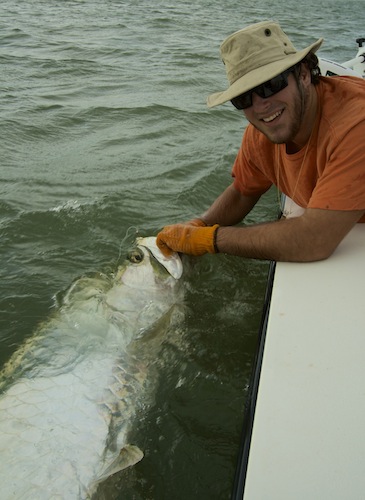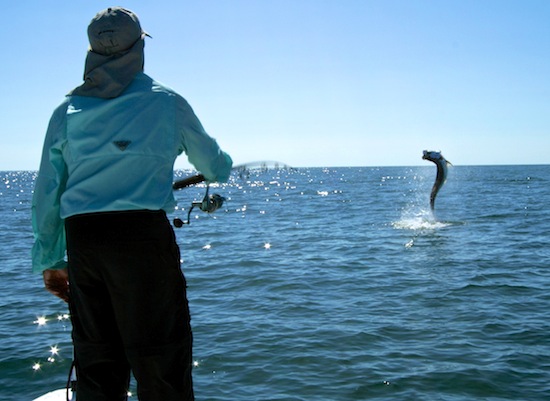Brevard’s Summertime Beach Tarpon
On the best day of fishing I ever had, Mac and Sherri Dye and I fought hundred-pound class tarpon two and three at a time until we were too exhausted to fish any more. It wasn’t even noon when we ran out of gas. Frankly, I don’t ever expect for that to happen again unless I end up in Heaven (an unlikely scenario), but excellent beach tarpon fishing can be had off the Brevard and Volusia county beaches all summer long. Here’s how to find it and cash in.
When
The fishing starts in the spring, ordinarily in May or June. It’s not as predictable as the tarpon run on the Gulf coast because it’s so baitfish dependent here. You need water temperatures of at least 75 degrees (79 is best), and you need to have a lot of bait. Nice weather with plenty of sunshine helps, too. If you have these things you will usually find tarpon.
Water temperatures fluctuate of course, but they generally remain acceptable to the fish into October. When the mullet run south then, the tarpon follow them. When you find the fish it can be fantastic fishing. After the mullet are gone, so are the big fish. It’s over until next year.
Equipment Needs
First, and unfortunately for many anglers, you must have a boat. You might hook a 100 pound tarpon from shore, but the chances of catching it if you can’t chase it are slim. The chance of getting spooled, on the other hand, is very good! I use a flats skiff but frankly, sometimes a 17 foot boat is a little too small. We are talking about the ocean here. A bay style boat of 20 to 22 feet is a better choice. The boat should have an outboard as well as an electric trolling motor. A bait well is almost necessary. Although you can catch these fish with artificials, you’ll have better success with bait.
You’ll need a cast net to catch that bait. I carry an eight foot all purpose net, but again, sometimes it’s too small and too light. If you find a school of menhaden in 30 feet of water, or a school of big black mullet in almost any depth of water, an eight foot net will catch few or none. They see it coming down and get out of the way. A heavy 10 or 12 foot, wide mesh net is what you need in this situation. I don’t make my living by throwing a cast net and so don’t have one of those, but the 12 foot net is the best tool for the job.
For tackle we use Shimano 6000 series reels loaded with 30 to 50 pound test Power Pro or similar braided line. At the end of that line a reverse Albright knot attaches five feet of 30 pound mono, and an Albright attaches another five feet of eighty pound fluorocarbon leader. At the end of that goes your lure, or a bait hook.
Lures will work. One of the best is DOA’s BFL. You make it look like a crippled mullet struggling on the surface and the strikes are mind boggling. Other effective DOA baits include the AdjustaFloater and the Swimming Mullet. Large swim baits will work, as will lipped plugs. I prefer using lures with as few hooks as possible to make releasing that fish less dangerous for both of us.
You can fly fish these fish. It’s difficult, though. Most of the time you’re in fairly deep water. The fish are seen rolling, not giving you a target. So you have to blind cast with big flies and a sinking line. Blind casting a 12-weight gets old real fast unless the bites are coming steadily, but in my experience that just doesn’t happen. I like to carry a fly rod in case we find laid up fish, but that’s a rare occurrence that requires a good deal of luck, and perfect weather and sea conditions.
For bait hooks you need a variety of sizes to match your bait size. I like Daiichi Circle Wides or Owner Muto Lights in sizes ranging from 6/0 (for smaller sized menhaden) to 12/0 (for big black mullet). When you’re using a mullet that weighs a pound or more, you need a sizable hook if you want to stick the eater!
Techniques
Unless you’ve gotten a hot tip from a fishing buddy, understand that you’re going on a search mission and that is no guarantee of success. You will run your boat out of one of the inlets and make a right or a left. It’s nice if you have your bait already but one of the things you hope to find is a big school of bait. If you haven’t caught any beforehand, you can catch it when you find it.
Get 100 yards of so off the beach and run, and look. What do you look for? Muds, for one thing. Menhaden (or pogies) will make muds in the ocean. If they are pogie muds you will see the fishies flapping on the surface. Get the net out and catch some. Keep an eye out for rolling beach tarpon while you do this.
 A better thing to find is a bunch of pogies with a lot of pelicans diving on them. If you find pogies and pelicans it’s virtually guaranteed that tarpon are there. Let me say that again- any time you see a lot of pelicans diving in an area you must go and check. If they are on menhaden the chance of tarpon being there is high.
A better thing to find is a bunch of pogies with a lot of pelicans diving on them. If you find pogies and pelicans it’s virtually guaranteed that tarpon are there. Let me say that again- any time you see a lot of pelicans diving in an area you must go and check. If they are on menhaden the chance of tarpon being there is high.
Once you get on the school of bait the birds are diving on, shut off the big engine and get on the trolling motor. You can toss a bait out while looking to see if the fish are more concentrated in one area than in others. The pogie schools can be very large. You want to be where the action is. Once you find the sweet spot use the trolling motor to maintain your position on it. It will move as the baits do. The fish seem not to be bothered much by the electric motor, perhaps because of the water depth. If there are good numbers of fish around you won’t have to wait long for a bite.
My best day that was described at the beginning of this piece happened that way. We came out of Ponce Inlet and headed south. We didn’t make it a quarter mile when we saw the pelicans diving. I throttled down and idled towards the action. A six foot long fish came flying out of the water, fairly hard to miss. I got on the trolling motor and caught some bait. We hooked the first fish about ten seconds after the first cast hit the water. It stayed like that all morning. We never went five minutes without having a fish on, with the biggest being about 130 pounds.
Another thing to look for are shrimp boats that are dragging nets. Get up between the nets and cast a bait astern of you. Don’t hook the net!
You can slow troll or drift with pogies or mullet if you find scattered rolling fish. I have caught fish this way, but it’s much slower than finding a big bait school loaded with fish. You take what you get, though.
A few years back we found a big school of migrating black mullet off of Patrick Air Force Base. They had a bunch of beach tarpon with them, so I netted a few mullet and we tried to use them for bait. It’s hard to cast a bait that weighs 16 or 20 ounces. In spite of that we jumped a dozen fish. The BFL hadn’t been introduced yet then, but it would have been perfect for that situation, easier to use than those fat mullet.
Other Considerations
You’re going to catch other species of fish. Big crevalle will test your tackle and patience. Blacktip, Atlantic sharpnose, spinner, and the occasional hammerhead sharks will take your baits. King mackerel and little tunny are possibilities. A cobia is unlikely, but could happen. As you get into October little one pound bluefish will drive you crazy if you try to use live baits.
Your baits don’t have to be alive, either. A dead bait is often taken as eagerly as a live one.
These are big, magnificent fish, 20 years old or more. If you’re bait fishing with circle hooks, come tight as soon as you’re bit. Tarpon have big mouths and they don’t need time to take the bait. Giving them time will only lead to gut hook-ups, not something that’s in the best interest of post-release survival.
Fight the fish hard. It should take 30 minutes or so to get one of these fish boatside. If you’re taking two or three hours you’re doing something wrong. The fish is likely to die because of it.
When the fish is boatside I put on a pair of orange gloves and grab the bottom jaw of the fish with both hands. I hold on for dear life and have the fisherman use pliers to unhook it. That’s why I like single hooks! A gaff is unnecessary and needlessly damages the fish.
Take the time to revive the fish after unhooking it. Use the trolling motor to move the boat as you drag the fish. He’ll let you know when it’s time to let go. You won’t be able to hold him any longer.
Wrapping Up
Now you know. You should go. Good luck catching Brevard’s summer beach tarpon!
Copyright © John A. Kumiski 2022. It is illegal to reproduce or distribute this work in any manner or medium without written permission from the author, John A. Kumiski, 284 Clearview Road, Chuluota, FL 32766 (407) 977-5207.
If you found this article useful and would like to donate to Spotted Tail, please click here…
![]()

